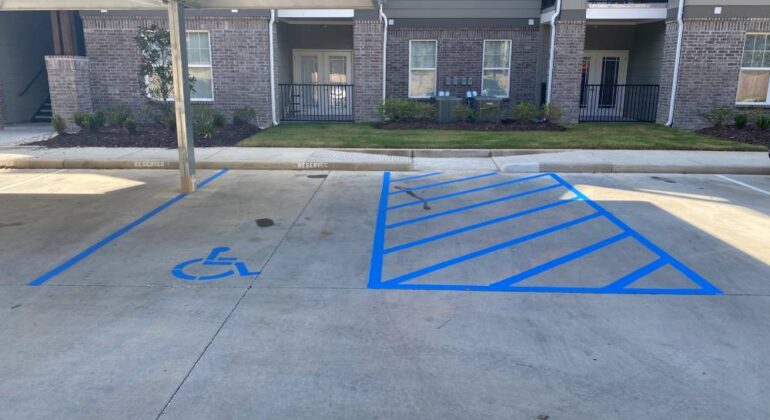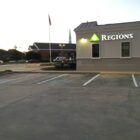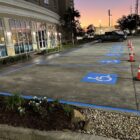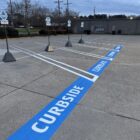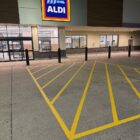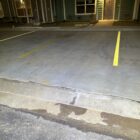Warehouses are massive buildings full of activity. No matter what type of product your warehouse holds or what equipment operates within it, the non-stop commotion can create safety hazards. A poorly maintained site with no floor striping can increase the risk of accidents, injuries and possible property damage. Fortunately, high-quality New Orleans warehouse striping can alleviate those problems.
In this blog, we’ll explore warehouse floor marking guidelines that can help create a safer and more efficient workplace.
What Can New Orleans Warehouse Striping Accomplish?
Warehouse striping isn’t about aesthetics. Lines and markings can significantly improve the safety of your property. Floor striping serves many purposes.
First, it helps identify potential hazards and important objects. Many warehouses use floor striping to quickly and efficiently alert workers of dangers that could pose injury. Striping also makes identifying important areas like equipment operation zones, trash receptacles, and production equipment much easier.
Warehouse floor markings also define work zones while improving traffic flow. Your warehouse may have specific sections for equipment operation, inventory management, production, etc. Warehouse striping companies can define those areas, making your property easier to navigate.
It’s also common to see established traffic lanes throughout the property. Depending on your needs, you might use warehouse striping to direct pedestrian traffic while keeping it separate from lanes used by forklifts and other equipment.
What Colors Should I Use for Warehouse Striping in New Orleans?
Floor markings in warehouses can be many different colors. To an outside, those colors may look randomly chosen. However, warehouse striping companies follow guidelines created by the Occupational Health and Safety Administration (OSHA).
Each color holds a specific meaning, and following the color-coded warehouse floor marking guidelines can make it easy for any employee to get around safely, even if it’s their first time visiting your site. Here’s a quick breakdown of common colors you may consider using on your warehouse floor markings.
- Yellow: Yellow floor markings in warehouse settings denote traffic lanes and aisleways.
- White: White is a color used to mark equipment without a specific color code. For example, it’s the go-to for denoting the placement of racks, floorstands, carts, etc.
- Red and White Stripes: The two-colored striping pattern indicates areas that must always remain clear. They usually mark areas that hold safety equipment.
- Black and White Stripes: Black and white stripes used for warehouse striping in New Orleans also indicate that areas must remain clear. However, that all-clear status aims to improve operations, not enhance safety.
- Black and Yellow Stripes: Black and yellow stripes alert employees to areas with physical safety and health hazards.
Other color standards exist. For example, OSHA recommends using orange to mark inspection areas and blue to denote raw material storage. However, the color palette used for your warehouse floor markings will depend on your warehouse’s operation.
Why Is It Better to Use Paint for New Orleans Warehouse Striping Versus Tape?
Taping is fine as a temporary measure when planning warehouse striping. Tape can help property owners and managers design the worksite and make adjustments to get things right. But once you cement a design, it’s important to hire warehouse striping companies for long-lasting paint.
Paint is a more durable and long-lasting option than tape. The biggest reason you want to avoid tape is that it can easily peel up. Accidental removal could lead to injury and property damage. Paint can last several years and only requires occasional touchups to remain vibrant.
Are There Any Official Warehouse Floor Marking Guidelines?
OSHA has several guidelines for warehouse striping New Orleans. What applies to your property depends on many factors, but following those regulations is important to ensure you’re remaining compliant and keeping your employees safe. OSHA has standards for marking areas that hold mechanical equipment, rules for marking emergency exits and alternative routes, etc. There are also regulations for what colors you use and how big certain areas and traffic lanes must be.
The best way to ensure you comply with OSHA regulations is to hire an experienced contractor. Skilled warehouse striping companies understand safety regulations and can work closely with you to develop a plan that exceeds OSHA standards.
Let Second Line Striping be your go-to source for New Orleans warehouse striping. We have many years of experience applying floor markings in warehouses, doing our part to keep workplaces of all sizes as safe and efficient as possible. You can trust us for all your striping needs. In addition to warehouse striping, we do parking lot striping, restriping, thermoplastic line markings, parking lot cleaning and more.
We proudly serve property owners in New Orleans, Baton Rouge, Lafayette, Covington, Metairie and the surrounding communities. We’re eager to show you what we can do!
Call Second Line Striping at (225)331-0062 to get a free quote. You can also reach us at mike@secondlinestriping.com or use our online contact form to get in touch.

